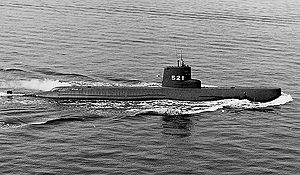Hayashio-class submarine
 JDSHayashio
| |
| Class overview | |
|---|---|
| Name | Hayashioclass |
| Builders | |
| Operators | |
| Preceded by | Oyashio |
| Succeeded by | Natsushioclass |
| Built | 1960–1962 |
| In commission | 1962–1979 |
| Planned | 2 |
| Completed | 2 |
| Retired | 2 |
| General characteristics | |
| Type | (Hunter-killer)submarine |
| Displacement |
|
| Length | 59 m (193 ft 7 in) |
| Beam | 6.5 m (21 ft 4 in) |
| Draft | 4.1 m (13 ft 5 in) |
| Propulsion |
|
| Speed |
|
| Complement | 43 |
| Armament | 3 × 533 mm (21 in) torpedo tubes |
TheHayashio-class submarinewas the successor design to theOyashio,and the predecessor of theNatsushioclasswith theJapan Maritime Self-Defense Force.Ordered in 1959, the boats were small with limited capability but were successful. Constructed in Japan from 1960 to 1962, they remained in service until 1979 when they were discarded.
Design and description[edit]
TheHayashioclass were based on theUnited States NavyBarracuda-class submarines.They were small with limited capability and were shorter and wider than the preceding JapaneseOyashio.[1]The main mission of the class was for operations in coastal waters.[2]They were air conditioned and provided quality habitability for their crews and were considered a successful submarine design.[3]They measured 59 meters (193 ft 7 in)long overallwith abeamof 6.5 m (21 ft 4 in) and adraftof 4.1 m (13 ft 5 in). They had a surfaceddisplacementof 650tonnes(640long tons) and 800 tonnes (790 long tons) submerged. Part of the design was to reduce hull resistance and to do this, external framing was used to improve internal space and create a betterdouble hull.They had a crew of 43.[1]
The submarines were propelled by twopropellershafts powered by adiesel-electricsystem composed of two Sulzer-Mitsubishidiesel enginescreating 1,300kilowatts(1,700shp) and two electric motors creating 970 kW (1,300bhp).[4]The main storage batteries were water-cooled. This gave the vessels a maximum speed of 15knots(28 km/h; 17 mph) surfaced and 12 knots (22 km/h; 14 mph) submerged.[1][a]To improve underwater maneuverability, ajoystickwas installed instead of the traditional wheel at the helm position. The submarines mounted threetorpedo tubesin thebowfor 533-millimeter (21.0 in)torpedoes.The class used a water pressure system to launch torpedoes that eliminated the creation of water bubbles.[1]
Boats[edit]
| Hayashioclass construction data[1][5] | ||||||
|---|---|---|---|---|---|---|
| Pennant no. | Name | Builder | Laid down | Launched | Commissioned | Fate |
| SS-521 | Hayashio(はやしお) | Shin Mitusbishi,Kobe | 6 June 1960 | 31 July 1961 | 30 June 1962 | Decommissioned 25 July 1977 |
| SS-522 | Wakashio(わかしお) | Kawasaki, Kobe | 7 June 1960 | 28 August 1961 | 17 August 1962 | Decommissioned 23 March 1979 |
Construction and career[edit]
Both submarines were ordered in 1959 from Japanese shipyards. BothHayashioandWakashioentered service in 1962.[1]On 20 May 1970,Hayashiocollided with a merchant vessel damaging the submarine's periscope.[6]They were both stricken from the naval vessel register in 1979, withWakashioon 23 July 1979.[1]
Notes[edit]
Citations[edit]
- ^abcdefgGardiner, Chumbley & Budzbon 1995,p. 235.
- ^Patalano 2015,141.
- ^abMoore 1976,p. 281.
- ^abCouhat 1976,p. 243.
- ^Moore 1979,p. 289.
- ^"Hải thượng tự vệ đội ニュース, thế giới の hạm thuyền".Hải nhân xã(in Japanese). Vol. 154. June 1970. p. 41.
References[edit]
- Couhat, Jean Labayle, ed. (1976).Combat Fleets of the World 1976/77: Their Ships, Aircraft, and Armament.Annapolis, Maryland: Naval Institute Press.ISBN0-87021-183-8.
- Gardiner, Robert; Chumbley, Stephen & Budzbon, Przemysław, eds. (1995).Conway's All the World's Fighting Ships 1947–1995.Annapolis, Maryland: Naval Institute Press.ISBN1-55750-132-7.
- Moore, John, ed. (1976).Jane's Fighting Ships 1976–77(79th ed.). New York: Franklin Watts Incorporated.ISBN0-531-03261-2.
- Moore, John, ed. (1979).Jane's Fighting Ships 1979–80(82nd ed.). New York: Franklin Watts Incorporated.ISBN0-531-03913-7.
- Patalano, Alessio (2015).Post-war Japan as a Sea Power: Imperial Legacy, Wartime Experience and the Making of a Navy.London: Bloomsbury.ISBN978-1-47252-682-3.
